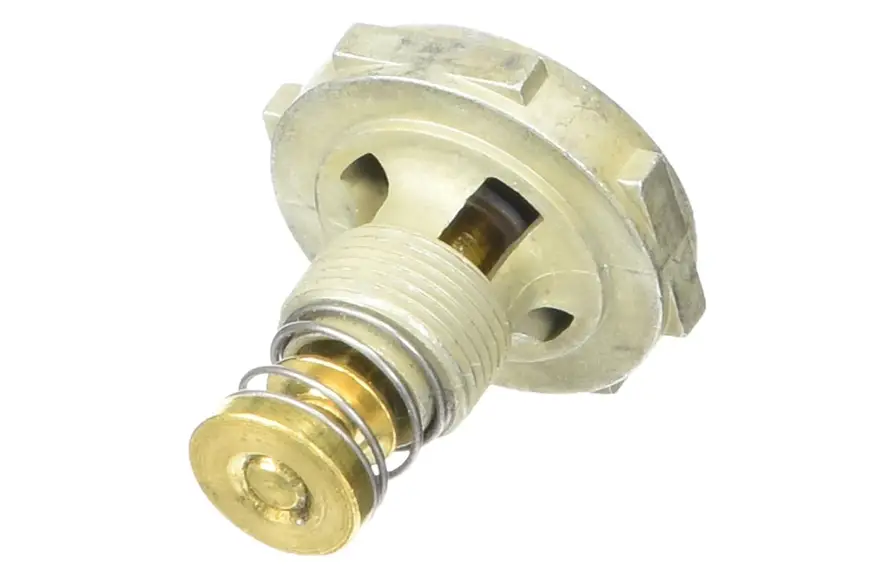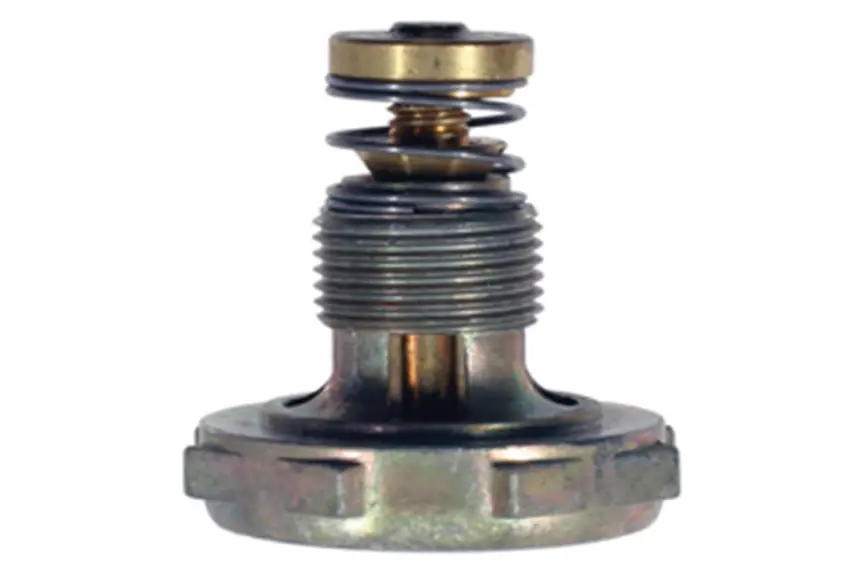The 4.5 and 6.5 power valves differ in the vacuum level at which they open, with the 4.5 opening at 4.5 in-Hg and the 6.5 at 6.5 in-Hg. The 4.5 valve is better suited for high-performance engines with lower vacuum, like those with aggressive camshafts, while the 6.5 is ideal for street engines with higher vacuum levels.
If you’re fine-tuning a carburetor for a high-performance engine, understanding the role of power valves is crucial. Among the different options, the 4.5 and 6.5 power valves are commonly discussed, but which one should you use, and what difference does it make?
In this post, we’ll dive into how these power valves function, their importance in the fuel delivery system, and what separates a 4.5 power valve from a 6.5 power valve.
Contents
What is a Power Valve?
A power valve is a critical component inside a carburetor, specifically within Holley-style carburetors, that controls fuel flow based on engine vacuum. Its primary purpose is to enrich the air-fuel mixture when the engine is under load, such as during hard acceleration or climbing steep hills. When manifold vacuum drops below a set level, the power valve opens, allowing more fuel to flow into the engine, preventing lean conditions that can lead to engine damage.
How Does a Power Valve Work?
The power valve operates based on engine vacuum levels. During normal driving or light acceleration, the engine produces a high vacuum, which keeps the valve closed. When you accelerate or place the engine under heavy load, the vacuum level drops. Once the vacuum dips below a certain threshold (measured in inches of mercury or “in-Hg”), the power valve opens and supplies additional fuel to the engine.
The power valve’s rating, such as 4.5 or 6.5, refers to the vacuum level at which the valve opens. A 6.5 power valve, for instance, opens when vacuum drops below 6.5 in-Hg, while a 4.5 power valve opens at 4.5 in-Hg.
4.5 Power Valve vs. 6.5 Power Valve: Key Differences
Here is a comparison table of 4.5 vs 6.5 power valve key difference –
| Feature | 4.5 Power Valve | 6.5 Power Valve |
|---|---|---|
| Vacuum Opening Point | 4.5 in-Hg | 6.5 in-Hg |
| Application | High-performance engines with aggressive cams | Street engines or mild performance builds |
| Fuel Enrichment Timing | Opens at lower vacuum levels, later enrichment | Opens at higher vacuum levels, earlier enrichment |
| Suitability for Cammed Engines | Ideal for engines with low idle vacuum | May not suit heavily cammed engines |
| Fuel Efficiency | Offers slightly leaner operation during low vacuum | Provides more fuel sooner, potentially reducing fuel economy |
| Driving Style | Suited for track or racing conditions | Suited for street use with occasional heavy loads |
When to Use a 4.5 Power Valve
The 4.5 power valve is designed for engines that operate at lower vacuum levels, typically found in high-performance or heavily cammed engines. These engines have lower vacuum signals, especially at idle, and using a 6.5 power valve would cause it to open prematurely, leading to excess fuel consumption.
Best Situations to Use a 4.5 Power Valve
- Aggressive Camshafts: Engines with camshafts designed for high RPM power often produce low idle vacuum. A 4.5 valve is better suited for these setups.
- Track/Racing Conditions: High-performance or drag racing setups benefit from a delayed fuel enrichment, which the 4.5 valve provides.
- Off-road or Extreme Loads: In off-road conditions or heavy towing, where vacuum levels drop significantly during operation, the 4.5 valve prevents early fuel dumping.
Using a 4.5 power valve ensures that fuel enrichment occurs only when absolutely necessary, preventing over-rich conditions and promoting cleaner operation during idle or light cruising.

When to Use a 6.5 Power Valve
The 6.5 power valve is more commonly used in street engines or mildly tuned performance engines. This valve is designed to open sooner than the 4.5, enriching the mixture at higher vacuum levels. For vehicles that operate primarily in normal driving conditions but occasionally require more fuel during heavy loads, the 6.5 valve provides a more responsive and smooth transition to richer mixtures.
Best Situations to Use a 6.5 Power Valve
- Daily Drivers: For street-driven vehicles, the 6.5 valve strikes a good balance between performance and efficiency.
- Mild Camshafts: Engines with mild cam profiles maintain higher vacuum at idle, making the 6.5 power valve appropriate.
- Occasional Heavy Loads: For drivers who only occasionally push their vehicle hard (like towing or spirited driving), the 6.5 valve allows for earlier fuel enrichment without drastically affecting fuel economy.
A 6.5 power valve enriches the mixture more quickly, which is useful for engines that spend more time under moderate loads or in variable driving conditions.

Power Valve Selection Based on Engine Vacuum
The choice between a 4.5 and 6.5 power valve should be guided by your engine’s vacuum readings at idle. Here’s a simple method to choose the correct valve:
- Measure the Manifold Vacuum: Using a vacuum gauge, measure your engine’s idle vacuum level. Make sure the engine is fully warmed up and running at a stable idle.
- Choose a Valve Based on Vacuum Reading: As a general rule, select a power valve with a rating that is about half of your engine’s idle vacuum. For example, if your engine idles at 12 in-Hg, a 6.5 power valve is appropriate. If it idles at 9 in-Hg, a 4.5 power valve would be a better fit.
The Consequences of an Incorrect Power Valve
Choosing the wrong power valve can lead to multiple issues, including poor performance, bad fuel economy, or even engine damage in extreme cases:
- Too High a Rating (e.g., using a 6.5 instead of a 4.5): The valve opens too soon, causing an over-rich fuel mixture, leading to reduced fuel economy and potential carbon buildup on spark plugs.
- Too Low a Rating (e.g., using a 4.5 instead of a 6.5): The valve opens too late, risking lean conditions under load, which can result in detonation or engine knock.
Frequently Asked Questions
Here are some FAQs about the difference between 4.5 and 6.5 power valve –
1. What is the primary difference between a 4.5 and 6.5 power valve?
The main difference lies in the vacuum threshold at which they open. A 4.5 power valve opens when vacuum drops below 4.5 in-Hg, while a 6.5 opens at 6.5 in-Hg.
2. How do I know which power valve to use for my engine?
Measure your engine’s idle vacuum and choose a power valve rated at roughly half the vacuum level. For example, if your engine idles at 9 in-Hg, a 4.5 power valve would be ideal.
3. Will a 6.5 power valve increase my fuel consumption?
A 6.5 power valve can potentially increase fuel consumption because it enriches the fuel mixture earlier, especially during heavy loads or acceleration.
4. Can using the wrong power valve damage my engine?
Yes, using a valve that opens too late can cause lean conditions under load, leading to engine knock, detonation, or overheating. Conversely, a valve that opens too early can cause excessive fuel consumption and fouled spark plugs.
5. What happens if I run a 4.5 power valve on a street-driven car?
In most street-driven cars with mild cams, a 4.5 power valve may delay fuel enrichment too much, leading to a lean mixture during acceleration, which can cause hesitation or knocking.
Conclusion
Choosing the right power valve for your carburetor is essential to optimize performance and efficiency. The 4.5 power valve is ideal for aggressive, high-performance setups with low idle vacuum, while the 6.5 power valve suits street applications and mild performance engines with higher idle vacuum. Always measure your engine’s vacuum before making a decision, and aim for a balance between power delivery and fuel economy.